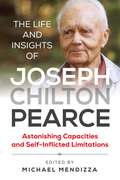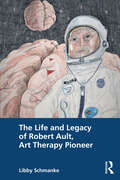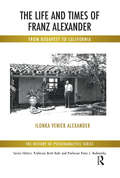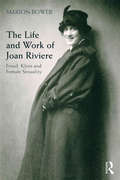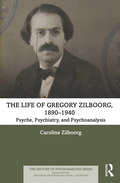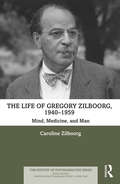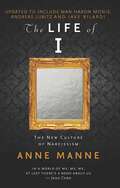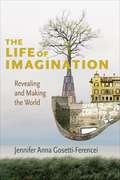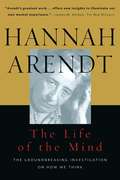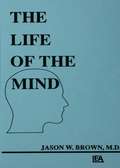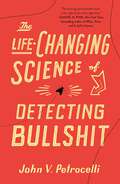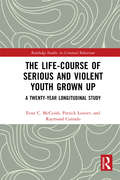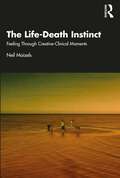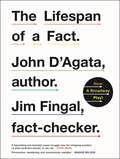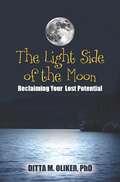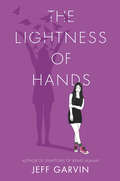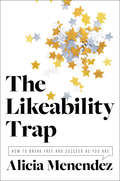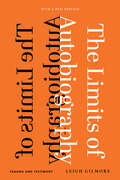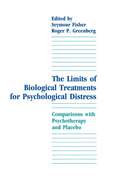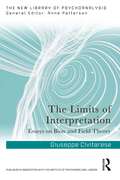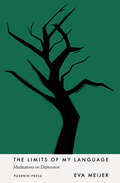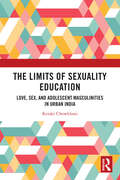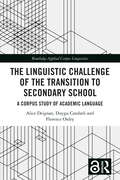- Table View
- List View
The Life and Insights of Joseph Chilton Pearce: Astonishing Capacities and Self-Inflicted Limitations
by Michael MendizzaA comprehensive guide to social visionary Joseph Chilton Pearce&’s work on the transcendent and magical potential of the human mind • Explores Pearce&’s most influential books, including Magical Child, sharing his life-changing insights into why we have become what we are, contrasted with the miracle nature intends us to be • Features essential passages interwoven with Pearce&’s own commentary, drawn from personal conversations and unpublished material • Shows how Pearce&’s key insights build across his books and break down core assumptions about reality and human potential An expert in child development, Joseph Chilton Pearce (1926-2016) devoted his life to exploring the optimum development and astonishing capacities within each individual human being. Across his 12 visionary books and thousands of lectures, he blended cutting-edge science with spirituality and explored the amazing power of imagination for both children and adults--the space where we are able to play with our reality--inspiring millions to discover the human birthright of a more magical world. In this guide to Pearce&’s complete vision of transcendent human potential, Michael Mendizza explores 7 of his most influential books, sharing insights and expertise from Pearce&’s full range of interests, from child development and conscious parenting to psychic phenomena and altered states to the power of the mind to shape reality. Offering essential passages interwoven with Pearce&’s own commentary, drawn from personal conversations and unpublished material, this book shows how Pearce&’s key insights build across his books, breaking down core assumptions about reality and human potential. We see the importance of imagination and empathic, non-verbal forms of wisdom, which have been long overshadowed--to the peril of humanity--by verbal-intellectual skills with their abstract concepts and ideological perspectives. Presenting Pearce&’s vision of human potential from the 1950s until the end of his life, this book shares Pearce&’s life-changing insights into why we have become what we are, contrasted with the miracle nature intends us to be, allowing each of us to break through our self-inflicted limitations and realize our amazing and magical potential.
The Life and Legacy of Robert Ault, Art Therapy Pioneer
by Libby SchmankeThis accessible book provides an edited and annotated compilation of selections of Robert Ault’s previously unpublished work, from presentations at psychiatric conferences to examples of his paintings and drawings. Ault’s manuscripts for presentations, workshop protocols, and art therapy directives that are otherwise unavailable are of great value to current and future art therapists and clinicians in fields like expressive arts therapy, counseling, social work, and psychology. As a mentee and close friend of Ault’s for the decade before his death, and with access to the full range of his unpublished and self-published material, author Libby Schmanke is ideally qualified to provide biographical and historical context and personal observations. This reference is beneficial for conceptualizing and applying art therapy, as well as having the historical value of preserving and honoring the work of a pioneer who sought to keep the art in art therapy.
The Life and Times of Franz Alexander: From Budapest To California (The History of Psychoanalysis Series)
by Ilonka Venier AlexanderFranz Alexander was the first graduate of the Berlin Psychoanalytic Institute, the man who turned down Freud's offer to enter into private practice in Vienna, and the man Freud told to go to America and spread the doctrine of psychoanalysis. He was also the grandfather of Ilonka Venier Alexander, the author of this remarkable account of one of the major figures of psychoanalysis in the twentieth century, set against the backdrop of the growth of analysis in America. The book considers his personal and professional life, the role of family in his decisions, and how those decisions affected other family members. Themes touched on in this intimate and personal biography include family secrets and lies, the fear of discovery and the need to reinvent one's past in order to survive, the importance of giving to society, and family reunification after decades of deceit and betrayal.
The Life and Work of Joan Riviere: Freud, Klein and Female Sexuality
by Marion BowerThe Life and Work of Joan Riviere traces her journey from dressmaker’s apprentice, and member of the Society for Psychical Research, to Sigmund Freud’s patient and his favourite translator. Marion Bower examines Riviere’s important legacy and contribution to the early development of psychoanalysis. Riviere was also a close friend and colleague of Melanie Klein and wrote her own highly original and influential papers on female sexuality and other topics, in particular Womanliness as a Masquerade (1929). Her position in the British Psychoanalytic Society was unusual as a direct link between Freud and Klein. Her own papers were extraordinarily prescient of developments in psychoanalysis, as well as the social climate of the time. Riviere’s experience as a dressmaker gave her an interest in female sexuality, and she proceeded to significantly challenge Freud’s views. She also defended Klein from ferocious attacks by Melitta Schmideberg (Klein's daughter) and Anna Freud. The Life and Work of Joan Riviere will appeal to anyone interested in the history of psychoanalysis as well as Riviere’s highly original perspectives involving feminist thought and female sexuality.
The Life of Gregory Zilboorg, 1890–1940: Psyche, Psychiatry, and Psychoanalysis (The History of Psychoanalysis Series)
by Caroline ZilboorgThe Life of Gregory Zilboorg, 1890–1940: Psyche, Psychiatry, and Psychoanalysis is the first volume of a meticulously researched two-part biography of the Russian-American psychoanalyst Gregory Zilboorg and chronicles the period from his birth as a Jew in Tsarist Russia to his prominence as a New York psychoanalyst on the eve of the Second World War. Educated in Kiev and Saint Petersburg, Zilboorg served as a young physician during the First World War and, after the revolution, as secretary to the minister of labour in Kerensky’s provisional government. Having escaped following Lenin’s takeover, Zilboorg requalified in medicine at Columbia University and underwent analysis with Franz Alexander at the Berlin Psychoanalytic Institute. His American patients ranged from wealthy and artistic figures such as George Gershwin and Lillian Hellman to prison inmates. His writing includes important histories of psychiatry, for which he is still known, as well as examinations of gender, suicide, and the relationship between psychiatry and the law. His socialist politics and late work on Freud’s (mis)understanding of religious belief created a wide circle of friends and acquaintances, from members of the Warburg banking family to the Trappist monk Thomas Merton. Drawing on previously unpublished sources, including family papers and archival material, The Life of Gregory Zilboorg, 1890–1940: Psyche, Psychiatry, and Psychoanalysis offers a dramatic narrative that will appeal to general readers as well as scholars interested in the First World War, the Russian revolution, the Jewish diaspora, and the history of psychoanalysis.
The Life of Gregory Zilboorg, 1940–1959: Mind, Medicine, and Man (The History of Psychoanalysis Series)
by Caroline ZilboorgThe Life of Gregory Zilboorg, 1940–1959: Mind, Medicine, and Man is the second volume of a meticulously researched two-part biography of the Russian-American psychoanalyst Gregory Zilboorg and chronicles the impact of the Second World War on his work and thinking as well as his divorce, remarriage, and conversion to Catholicism. With extensive references to Zilboorg’s writing and politics, this book demonstrates the significance of his contributions to the fields of psychiatry and psychoanalysis in the context of his tumultuous intellectual, personal, and spiritual life. In his late work, he would argue, controversially, that there was no incompatibility between psychoanalysis and religion. Grounded in a wealth of primary source material and impressive research, this book completes the compelling biography of a major figure in psychoanalysis. It will be of interest to general readers as well as scholars across a range of disciplines, particularly the history of psychoanalysis and religion.
The Life of I: The New Culture of Narcissism: Updated Edition
by Anne ManneFar from being the work of a madman, Anders Breivik's murderous rampage in Norway was the action of an extreme narcissist. As the dead lay around him, he held up a finger asking for a Band-Aid. Written with the pace of a psychological thriller, The Life of I is a compelling account of the rise of narcissism in individuals and society. Manne examines the Lance Armstrong doping scandal and the alarming rise of sexual assaults in sport and the military, as well as the vengeful killings of Elliot Rodger in California. She looks at narcissism in the pursuit of fame and our obsession with 'making it'. She goes beyond the usual suspects of social media and celebrity culture to the deeper root of the issue: how a new narcissistic character-type is being fuelled by a cult of the self and the pursuit of wealth in a hypercompetitive consumer society. The Life of I also offers insights from the latest work in psychology, looking at how narcissism develops. But Manne also shows that there is an alternative: how to transcend narcissism, to be fully alive to the presence of others; how to create a world where love and care are no longer turned inward.
The Life of Imagination: Revealing and Making the World
by Jennifer Anna Gosetti-FerenceiImagination allows us to step out of the ordinary but also to transform it through our sense of wonder and play, artistic inspiration and innovation, or the eureka moment of a scientific breakthrough. In this book, Jennifer Anna Gosetti-Ferencei offers a groundbreaking new understanding of its place in everyday experience as well as the heights of creative achievement.The Life of Imagination delivers a new conception of imagination that places it at the heart of our engagement with the world—thinking, acting, feeling, making, and being. Gosetti-Ferencei reveals imagination’s roots in embodied human cognition and its role in shaping our cognitive ecology. She demonstrates how imagination arises from our material engagements with the world and at the same time endows us with the sense of an inner life, how it both allows us to escape from reality and aids us in better understanding it. Drawing from philosophy, cognitive science, evolutionary anthropology, developmental psychology, literary theory, and aesthetics, Gosetti-Ferencei engages a spectacular range of examples from ordinary thought processes and actions to artistic, scientific, and literary feats to argue that, like consciousness itself, imagination resists reductive explanation. The Life of Imagination offers a vital account of transformative thinking that shows how imagination will be essential in cultivating a future conducive to human flourishing and to that of the life around us.
The Life of the Heroin User: Typical Beginnings, Trajectories and Outcomes
by Shane DarkeHeroin is a worldwide scourge and a seemingly intractable one. The Life of the Heroin User: Typical Beginnings, Trajectories and Outcomes is the first book to apply a biographical approach to the lifecycle of the heroin user from birth until death. Chapters address each stage of the user's life, including childhood, routes to use, the development of dependence, problems arising from addiction, death and options for treatment and prevention. Drawing on over two decades of experience in the field of opium research, Shane Darke examines major theoretical approaches to the development of opiate dependence and the efficacy of treatment options for opiate dependence. Key points are presented at the end of each chapter. The most detailed review available of what is likely to happen to the dependent heroin user, this is an important book for clinicians, researchers and students in the fields of drug and alcohol studies and public health.
The Life of the Mind
by Hannah ArendtThis work is a rich, challenging analysis of man's mental activity, considered in terms of thinking, willing, and judging. Originally published in two separate volumes with subtitles: Thinking, and Willing. Includes bibliographical references and indexes.
The Life of the Mind (Comparative Cognition and Neuroscience Series)
by Jason W. BrownThis detailed look at the development of microgenetic theory provides a comprehensive and coherent model of cognitive processing in the brain, based on patterns of breakdown in pathology. In so doing, it illustrates the clinical record that supports and documents microgenetic theory, and presents a basis for future work in the study of the brain. Coverage includes topics in language and dominance, the function of the right hemisphere, action, perception, memory, and the concept of time.
The Life-Changing Science of Detecting Bullshit
by John V. PetrocelliExpanding upon his viral TEDx Talk, psychology professor and social scientist John V. Petrocelli reveals the critical thinking habits you can develop to recognize and combat pervasive false information that harms society in The Life-Changing Science of Detecting Bullshit.Bullshit is the foundation of contaminated thinking and bad decisions leading to health consequences, financial losses, legal consequences, broken relationships, and wasted time and resources.No matter how smart we believe ourselves to be, we’re all susceptible to bullshit—and we all engage in it. While we may brush it off as harmless marketing sales speak or as humorous, embellished claims, it’s actually much more dangerous and insidious. It’s how Bernie Madoff successfully swindled billions of dollars from even the most experienced financial experts with his Ponzi scheme. It’s how the protocols of Mao Zedong’s Great Leap Forward resulted in the deaths of 36 million people from starvation. Presented as truths by authority figures and credentialed experts, bullshit appears legitimate, and we accept their words as gospel. If we don’t question the information we receive from bullshit artists to prove their thoughts and theories, we allow these falsehoods to take root in our memories and beliefs. This faulty data affects our decision making capabilities, sometimes resulting in regrettable life choices. But with a little dose of skepticism and a commitment to truth seeking, you can build your critical thinking and scientific reasoning skills to evaluate information, separate fact from fiction, and see through bullshitter spin. In The Life-Changing Science of Detecting Bullshit, experimental social psychologist John V. Petrocelli provides invaluable strategies not only to recognize and protect yourself from everyday bullshit, but to accept your own lack of knowledge about subjects and avoid in engaging in bullshit just for societal conformity.With real world examples from people versed in bullshit who work in the used car, real estate, wine, and diamond industries, Petrocelli exposes the red-flag warning signs found in the anecdotal stories, emotional language, and buzzwords used by bullshitters that persuade our decisions. By using his critical thinking defensive tactics against those motivated by profit, we will also learn how to stop the toxic misinformation spread from the social media influencers, fake news, and op-eds that permeate our culture and call out bullshit whenever we see it.
The Life-Course of Serious and Violent Youth Grown Up: A Twenty-Year Longitudinal Study (Routledge Studies in Criminal Behaviour)
by Patrick Lussier Evan C. McCuish Raymond CorradoThe Life-Course of Serious and Violent Youth Grown Up addresses significant gaps in the literature on youth involved in chronic, serious, and violent offending. Through longitudinal research and a long follow-up into adulthood, it challenges common perceptions about offending outcomes. Using theoretically grounded, methodologically sophisticated and empirically driven research, this book culminates 20 years of data emerging from the Incarcerated Serious and Violent Young Offender Study (ISVYOS). Initiated in 1998 to understand the origins of serious and violent youth offending, it follows 1,719 formerly incarcerated youth through adulthood and offers a contemporary perspective to questions about chronic offending in adolescence and social and offending outcomes in adulthood. The authors provide a theoretically framed examination of new findings from the ISVYOS regarding participants’ justice system involvement, from onset to persistence to desistance. Most participants experienced continued involvement in the justice system in adulthood. However, contrary to past literature, ISVYOS findings challenge static descriptions of chronic offending and notions of the youth "super predator". ISVYOS findings also challenge assertions that experiences and risk factors in childhood and adolescence are not informative of adult justice system involvement. Together, the findings call for a more humanistic approach that recognizes that the complex lives of individuals formerly incarcerated in adolescence implies that desistance does not happen by default. This book will be of great interest to scholars, researchers, and students of forensic psychology, developmental and life course criminology, youth justice, and violent crime.
The Life-Death Instinct: Feeling Through Creative-Clinical Moments
by Neil MaizelsThroughout this enlightening collection, Neil Maizels considers the helical tandem between the Life Instinct and the Death drive in the light of canonical literary figures like Thomas Hardy, Patricia Highsmith, Sylvia Plath and Shakespeare, classic filmmakers like Hitchcock and contemporary television shows such as Curb Your Enthusiasm, The West Wing and Succession. This light is filtered through intricate clinical work whereby Maizels seeks to illustrate and expound on the strength and indefatigability of the Life Instinct. He makes a case for it as the relentless driver of integration and “binding” in the ever-growing, expansive psyche. He considers both Freud’s original equation of the Life Instinct with Eros and a widening interconnecting love of mankind, and Melanie Klein’s with gratitude and creative reparation. This book is a multi-layered presentation of the clinical and theoretical work of Neil Maizels as it has evolved and convolved over several decades. It places the feeling through of one’s conflicts at the heart of the mind’s generation of a unique identity, equipped to evolve its own unique form of creative spirit in the face of life’s most pressing psychological challenges: the limitation of time, and reciprocated beauty. The Life-Death Instinct: Feeling Through Creative-Clinical Moments is important reading for anyone seeking to expand their knowledge in this fascinating intersection of psychoanalysis and the arts.
The Lifespan of a Fact: Now a Broadway Play
by John D'Agata Jim FingalNOW A BROADWAY PLAY STARRING DANIEL RADCLIFFE'Provocative, maddening and compulsively readable' Maggie NelsonIn 2003, American essayist John D'Agata wrote a piece for Harper's about Las Vegas's alarmingly high suicide rate, after a sixteen-year-old boy had thrown himself from the top of the Stratosphere Tower.The article he delivered, 'What Happens There', was rejected by the magazine for inaccuracies. But it was soon picked up by another, who assigned it a fact checker: their fresh-faced intern, and recent Harvard graduate, Jim Fingal. What resulted from that assignment, and beyond the essay's eventual publication in the magazine, was seven years of arguments, negotiations, and revisions as D'Agata and Fingal struggled to navigate the boundaries of literary nonfiction.This book includes an early draft of D'Agata's essay, along with D'Agata and Fingal's extensive discussion around the text. The Lifespan of a Fact is a brilliant and eye-opening meditation on the relationship between 'truth' and 'accuracy', and a penetrating conversation about whether it is appropriate for a writer to substitute one for the other.'A fascinating and dramatic power struggle over the intriguing question of what nonfiction should, or can, be' Lydia Davis
The Light Side of the Moon
by Ditta M. OlikerLearn about the unconscious survival systems developed in childhood to protect ourselves. Ditta M. Oliker shows us how to recognize and dismantle these systems now that they have outlived their usefulness and how to achieve personal fulfillment in the present.Ditta M. Oliker, PhD, is a founding member of Los Angeles' Mark Taper Forum. Her PhD in Clinical Psychology is from CSPP, Los Angeles, and she has been in private practice for more than thirty years. She is a frequent lecturer at universities and mental health facilities.
The Lightness of Hands
by Jeff GarvinA quirky and heartfelt coming-of-age story about a teen girl with bipolar II who signs her failed magician father up to perform his legendary but failed illusion on live TV in order to make enough money to pay for the medications they need—from the author of Symptoms of Being Human. Perfect for fans of Adi Alsaid, David Arnold, and Arvin Ahmadi. Sixteen-year-old Ellie Dante is desperate for something in her life to finally go right. Her father was a famous stage magician until he attempted an epic illusion on live TV—and failed. Now Ellie lives with her dad in a beat-up RV, attending high school online and performing with him at birthday parties and bars across the Midwest to make ends meet.But when the gigs dry up, their insurance lapses, leaving Dad’s heart condition unchecked and forcing Ellie to battle her bipolar II disorder without medication.Then Ellie receives a call from a famous magic duo, who offer fifteen thousand dollars and a shot at redemption: they want her father to perform the illusion that wrecked his career—on their live TV special, which shoots in Los Angeles in ten days. Ellie knows her dad will refuse—but she takes the deal anyway, then lies to persuade him to head west. With the help of her online-only best friend and an unusual guy she teams up with along the way, Ellie makes a plan to stage his comeback. But when her lie is exposed, she’ll have to confront her illness and her choices head-on to save her father—and herself.
The Likeability Trap: How to Break Free and Succeed as You Are
by Alicia MenendezBe nice, but not too nice. Be successful, but not too successful. Just be likeable. Whatever that means?Women are stuck in an impossible bind. At work, strong women are criticized for being cold, and warm women are seen as pushovers. An award-winning journalist examines this fundamental paradox and empowers readers to let go of old rules and reimagine leadership rather than reinventing themselves.Consider that even competent women must appear likeable to successfully negotiate a salary, ask for a promotion, or take credit for a job well done—and that studies show these actions usually make them less likeable. And this minefield is doubly loaded when likeability intersects with race, ethnicity, sexual orientation, and parental status. Relying on extensive research and interviews, and carefully examined personal experience, The Likeability Trap delivers an essential examination of the pressure put on women to be amiable at work, home, and in the public sphere, and explores the price women pay for internalizing those demands. Rather than advising readers to make themselves likeable, Menendez empowers them to examine how they perceive themselves and others and explores how the concept of likeability is riddled with cultural biases. Our demands for likeability, she argues, hinder everyone’s progress and power.Inspiring, thoughtful and often funny, The Likeability Trap proposes surprising, practical solutions for confronting the cultural patterns holding us back, encourages us to value unique talents and styles instead of muting them, and to remember that while likeability is part of the game, it will not break you.
The Limits of Autobiography: Trauma and Testimony
by Leigh GilmoreIn The Limits of Autobiography, Leigh Gilmore analyzes texts that depict trauma by combining elements of autobiography, fiction, biography, history, and theory in ways that challenge the constraints of autobiography. Astute and compelling readings of works by Michel Foucault, Louis Althusser, Dorothy Allison, Mikal Gilmore, Jamaica Kincaid, and Jeanette Winterson explore how each poses the questions "How have I lived?" and "How will I live?" in relation to the social and psychic forms within which trauma emerges. First published in 2001, this new edition of one of the foundational texts in trauma studies includes a new preface by the author that assesses the gravitational pull between life writing and trauma in the twenty-first century, a tension that continues to produce innovative and artful means of confronting kinship, violence, and self-representation.
The Limits of Biological Treatments for Psychological Distress: Comparisons With Psychotherapy and Placebo
by Roger P. Greenberg Seymour FisherBroadly scanning the biologically oriented treatments for psychological disorders in 20th century psychiatry, the authors raise serious questions about the efficacy of the somatic treatments for psychological distress and challenge the widespread preference for biologically based treatments as the treatments of choice. For graduate and undergraduate courses in clinical, social, and health psychology, behavioral medicine, psychotherapy and psychoanalysis. psychopharmacology, psychiatry, and clinical social work.
The Limits of Interpretation: Essays on Bion and Field Theory (The New Library of Psychoanalysis)
by Giuseppe CivitareseThe Limits of Interpretation opens a window onto unexplored dimensions of Wilfred Bion’s thought, presenting essays that illuminate both familiar and lesser‑known facets of his work. It guides readers through complex notions such as visible‑invisible hallucinations, bizarre objects, and a radical reframing of the Oedipus complex – shifted from incest and parricide to arrogance and the desire for knowledge.Taking various of Bion’s key works in turn, Civitarese explores what is unique about Bion’s thinking on essential topics such as projective identification, infantile development, and intuition, to shed light on the continued importance of Bion’s early work, in particular for contemporary psychoanalysis. By focusing on Bion’s Kleinian‑phase essays, this volume highlights their pivotal role in comprehending his entire theoretical landscape and how far they extend beyond traditional Freudian and Kleinian frameworks. It even poses the question: was Bion ever truly a Kleinian?Offering a close reading and clear interpretation of Bion’s sometimes dense writing, this is essential reading for any psychoanalysts or psychotherapists wanting to understand Bion’s work better.
The Limits of My Language: Meditations on Depression
by Eva Meijer"Moving, poetic, cogent and honest." -- Andrew Solomon, author of The Noonday Demon An intimate study of depression that draws on personal experience and a deep knowledge of philosophy—perfect for fans of Maggie Nelson and Leslie JamisonThe Limits of My Language is both a razor-sharp analysis of depression and a steadfast search for the things great and small -- from philosophy and art to walking a dog or sitting quietly with a cat -- that make our lives worth living. Much has been written about the treatment of depression, but relatively little about its meaning. In this strikingly original book, Eva Meijer weaves her own experiences and the insights of thinkers from Freud to Foucault and Woolf into a moving and incisive evocation of the condition. Depression is more than a chemical problem—the questions that occupy someone with depression are fundamentally human, and they touch on other philosophical questions that concern language, autonomy, power relations, loneliness, and the relationship between body and mind. But this book-length essay is also about the other side, such as animals, trees, others, art: about consolation, and hope, and the things that can give life meaning. The Limits of My Language explores how depression can make us grow out of shape over time, like a twisted tree, how we can sometimes remould ourselves in conversation with others, and how to move on from our darkest thoughts.
The Limits of Sexuality Education: Love, Sex, and Adolescent Masculinities in Urban India
by Ketaki ChowkhaniThis book explores different strands of thinking about sexuality education in contemporary urban India. It interrogates the limits of sexuality education as we know it today by rethinking adolescent masculinities in middle-class urban India. This book contributes to the wide gap in theorising sexuality education and adolescent masculinities in urban India. It presents an adolescent perspective on sexuality education, looks at adolescent love from the school teachers’ perspective, and tries to understand a teacher’s negotiations with student romance. It unravels the sexual and romantic lives of adolescents and examines the circulation of sexual knowledge and sources of information on sex that adolescent boys in India have access to. This book uncovers the limits of sexuality education by examining State, feminist, Christian, and sexological materials on sexuality education in Mumbai and Delhi. Based on detailed research and narratives from teachers, young men, and women, the book explores adolescent male romance and its affective registers, adolescent male sexual knowledge, and the regulation of romance in school spaces. This book will be of interest to students and researchers of education, sexuality and gender studies, masculinity studies, sex education as well as those interested in education policy, education politics, educational research, and inclusion and special education. Located at the intersection of sexuality studies, education, masculinity studies, and cultural studies, it will also appeal to those working in sexuality education in urban India within the complex web of the middle classes, consumerism, post-feminism, romance, adolescent masculinities, and cinema.
The Linguistic Challenge of the Transition to Secondary School: A Corpus Study of Academic Language (Routledge Applied Corpus Linguistics)
by Alice Deignan Duygu Candarli Florence OxleyThis book provides a unique analysis and description of the linguistic challenges faced by school students as they move from primary to secondary school, a major transition, which some students struggle with emotionally and academically. The study: • draws on a bespoke corpus of 2.5 million words of written materials and transcribed classroom recordings, provided by the project's partner schools; • combines quantitative and qualitative approaches to the corpus data to explore linguistic variation across school levels, registers and subjects; • describes the procedures of corpus compilation and analysis of written and spoken academic language, showing how modern corpus tools can be applied to this far-reaching social and educational issue; • uncovers differences and similarities between the academic language that school children are exposed to at primary and secondary school, contrasting this against the backdrop of the non-academic language that they encounter outside school. This book is important reading for advanced students and researchers in corpus linguistics, applied linguistics and teacher education. It carries implications for policymakers and schools looking to support students at this critical point in their schooling.
The Linguistic Shaping of Thought: A Study in the Impact of Language on Thinking in China and the West
by A. H. Bloom Alfred H. BloomFirst published in 1981. Routledge is an imprint of Taylor & Francis, an informa company.
